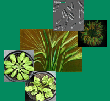Functionality in a Tropical Mountain Rainforest of South Ecuadorf: Diversity, Dynamic Processes and Utilization Potentials under Ecosystem Perspectives
DFG FOR 402
From 01/2002 to 12/2005Principal Investigator: Erwin Beck
Introduction The forests of the Ecuadorian Andes represent one of the (plant) species richest and one of the “hottest” of the biodiversity-hotspots worldwide (Brummitt & Lughadha 2003). At the same time, this country suffers the highest deforestation rate in South America (FAO, 2003). Even without human interference, the forests, as a result of high precipitation regimes and the steepness of the slopes, are subjected to an extraordinarily high “natural” dynamics which is both destabilizing (land slides) as well as stabilizing (the biodiversity) because of the dynamic momentum. The study area of the Research Unit 402 of the German Research Foundation is situated in the Eastern range of the South Ecuadorian Andes in the deeply incised valley of the Rio San Francisco. The Research Station “Estacion Cientifica San Francisco” (ECSF) established in the years 1996 – 1999 by the foundation “Nature and Culture International” is situated on the valley-bottom at 1850 m a.s.l. near the communication road between the two province capitals of Loja and Zamora. The southern slopes (exposed to the north) are covered by a more or less dense forest, the so-called “ECSF forest”, while the forest on the northern slopes (exposed to the south) has largely been cleared by the “Colonos”, the new settlers, by slash and burn. Nowadays only parts of the cleared areas are still utilized, mainly as pasture land. The interdisciplinary Research Unit which was established in 2001, has two main objectives: i) a scientific understanding of the ecosystem “tropical mountain rain forest”, and based on this, ii) the investigation of the potential of this ecosystem for sustainable use by humans. Comparing the natural forest ecosystem on the orographic right-hand slopes with the ecosystems of „agricultural lands“ and “abandoned farming lands“ on the left side of the valley mutually interlinks these two goals.
Homepage: http://www.bergregenwald.de/

